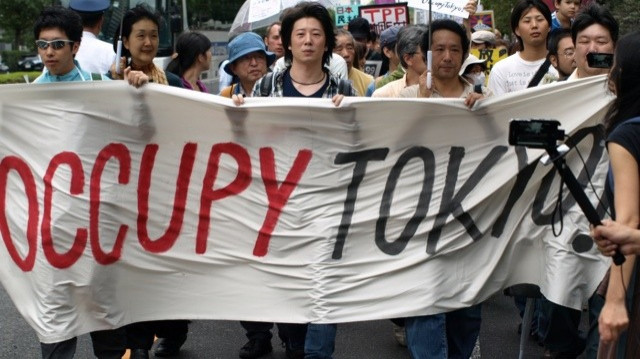Occupy Tokyo Grows out of OWS into Unique Mass Movement

Occupy Tokyo is one of East Asia's most significant outgrowths of the Occupy Wall Street movement that has swept the world over the past two months, but most media sources have ignored it.
Calls from social media users have grown over the past few days for mainstream media sources to cover Occupy Tokyo protests, and a couple have, but the big news players have mostly ignored one of the largest local movements to arise in solidarity with OWS.
The language used by Occupy Tokyo's supporters and in its informational materials echoes that of other occupy outposts throughout the world, and the goals are similar except for one major deviation.
As is the case with New York, Australia, and European occupy groups, the Japanese protest movement uses slogans such as We are the 99 percent to protest economic inequality and other societal ills.
But one crucial difference exists in the Tokyo iteration in the fact that its supporters have joined forces with protesters of a different shade, the ones who have been decrying what they call a national cover-up of the ongoing negative impacts of the near-nuclear-crisis at the Fukushima nuclear plant March 11.
A 9.0-magnitude earthquake and tsunami that day decimated a large swath of Japan's northeastern coast, leaving 20,000 dead or missing, and forcing 100,000 people out of their homes. There is still no word as to when the displaced families will be able to return to the area.
It also caused a severe nuclear event at the plant, releasing radioactive materials including plutonium into the environment, and protesters argue that the government is not doing enough to protect residents from exposure to radiation and other possible impacts of the damage to the plant.
We Are the 99.9% Expands to Japan
The movement to liberate the people of the world from corrupt banking and radioactive pollution has begun, reads a description of the group on one of its associated Facebook pages. We are the 99.9%. We will not be silent. Also in Japan!
And the Occupy Tokyo furor may build to a new peak in coming days over what protesters bill as their government's failure to deal with the fallout -- literally and figuratively -- of that disaster, as a 5.9-magnitude earthquake hit just 62 miles from the Fukishima plant Wednesday, according to an Associated Press report in the Washington Post, though no damage was reported. Each new incident just drives home to protesters' their belief that it is imperative that the government to address the possible weak spots of its nuclear power system in the most seismically active area in the world.
And the natural disasters are not showing any signs of letting up, which likely only feeds the protesters' outrage, as the latest one came just day after a 5.5-magnitude tremblor that could be felt in Tokyo hit northern Japan Sunday. The quake did not damage the Fukushima plant, Reuters reported.
The epicenters of the Occupy Tokyo protests have corollaries to the ones in New York, in that they are based in financial districts in hope of making their opinions known by the richest 1 percent of the country's residents.
In New York, Zuccotti Park near Wall Street is the OWS home base, in Tokyo it is Hibiya Park, located near the Imperial Palace and key governmental and financial buildings. Wall Street is the target of the movement's derision in America, in Tokyo the protests are spreading also to the bustling Roppongi district near a Goldman Sachs building and near the government seat in Shinjuku.
As the Sign of the Times website reports, the protests have gotten little coverage in local media, and even less worldwide, but the movement is sizeable and active.
Several large demonstrations have taken place all over Japan in recent months, especially in Tokyo, according to SOTT. The general mood is the same as elsewhere: ordinary people in Japan are fed up with their leaders' lies, particularly the lies told by TEPCO, the Tokyo Electric Power Company, and how the government has handled the Fukushima disaster. Or rather, how it has avoided handling it.
The demonstrations have gone on for months and intensified since September, as SOTT reports: On Sept. 11 protesters formed a human chain around a key governmental building and four protesters faster for 10 days to protest Japan's plans to build more nuclear power plants despite the risks; on Sept. 19, 40,000 people attended an anti-nuclear-power protest in a Tokyo park; Occupy Tokyo launched Oct. 15, leading to a string of massive protests that show no sign of stopping.
© Copyright IBTimes 2025. All rights reserved.




















